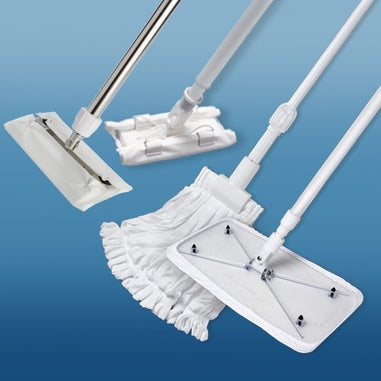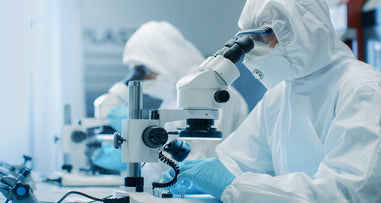- No products in the cart.
In the world of science, technology, and manufacturing, precision and purity are paramount. Whether you're developing advanced microchips, manufacturing pharmaceuticals, or conducting cutting-edge research, maintaining a sterile environment is crucial to success. One of the key tools in achieving this sterility is the cleanroom bunny suit. In this guide, we'll explore the science behind cleanroom bunny suits and their vital role in creating and maintaining sterile environments.
What Is a Cleanroom Bunny Suit?
A cleanroom bunny suit, also known as a cleanroom coverall or cleanroom jumpsuit, is a specialized garment designed to minimize contamination in controlled environments. These environments, known as cleanrooms, are essential in industries where even tiny particles or contaminants can lead to product defects, equipment malfunction, or compromised research results.
Cleanroom bunny suits typically consist of a one-piece jumpsuit made from specific materials that minimize the shedding of particles and dust. They cover the entire body, including the head, and are often paired with additional accessories like gloves, booties, and hoods to create a sealed, sterile environment around the wearer.
The Science Behind Cleanroom Materials
The choice of materials for cleanroom bunny suits is critical to their effectiveness in maintaining a sterile environment. These materials are carefully selected to minimize shedding, static electricity, and the release of contaminants. Here are some key aspects of the science behind cleanroom materials:
1. Particle Filtration
Cleanroom bunny suits are made from materials that have excellent particle filtration properties. These materials have a tight weave or structure that prevents the entry or exit of particles, dust, and microorganisms. Common materials used in cleanroom suits include polyester, microfiber, and polyethylene.
2. Static Control
Static electricity can attract and trap particles on the surface of garments, which can then be released into the cleanroom environment. To combat this, cleanroom bunny suits are often treated with anti-static coatings or made from inherently static-dissipative materials. This prevents the buildup of static charge and reduces the risk of particle contamination.

3. Lint-Free
Lint from clothing can contain a variety of contaminants, including fibers, oils, and dust. Cleanroom bunny suits are designed to be lint-free, meaning they do not shed particles or fibers that can compromise the sterile environment. This is achieved through the selection of materials and manufacturing processes that minimize lint generation.
4. Liquid Repellent
In some cleanroom applications, protection against liquid contaminants is essential. Cleanroom bunny suits may be treated with liquid-repellent coatings or made from materials that are inherently resistant to liquids. This helps prevent spills or splashes from contaminating the wearer's body or the cleanroom environment.
The Role of Cleanroom Garments in Contamination Control
Cleanroom bunny suits play a critical role in contamination control within cleanrooms and other controlled environments. Here's how they contribute to maintaining sterility:
1. Personnel Contamination Control
Humans are a significant source of contamination in cleanrooms. Skin flakes, hair, and respiratory droplets can all introduce particles and microorganisms into the environment. Cleanroom bunny suits create a barrier between the wearer and the cleanroom, minimizing the release of contaminants from the wearer's body.
2. Particle Shedding Control
As mentioned earlier, cleanroom bunny suits are designed to minimize particle shedding. This is achieved through the use of appropriate materials and construction techniques. By reducing the release of particles from the garment's surface, cleanroom bunny suits help maintain the cleanliness of the controlled environment.
3. Protecting Products and Equipment
In industries like semiconductor manufacturing and pharmaceuticals, even a single particle of contamination can result in product defects or equipment malfunctions. Cleanroom bunny suits protect both the wearer and the products or equipment in the cleanroom from potential contamination.
4. Sterile Procedures
In cleanroom environments where sterile procedures are crucial, such as in pharmaceutical manufacturing or biotechnology research, cleanroom bunny suits are an integral part of the overall protocol. They ensure that personnel adhere to strict hygiene standards, minimizing the risk of introducing contaminants into critical processes.
Proper Cleanroom Bunny Suit Usage
Using cleanroom bunny suits effectively requires more than just putting them on. Proper procedures must be followed to ensure their full functionality. Here are some key steps in using cleanroom bunny suits:
1. Gowning and Degowning
Before entering a cleanroom, personnel must go through a gowning process, which includes putting on the cleanroom bunny suit, gloves, booties, and a hood. The process is carefully controlled to prevent contamination. Degowning is the reverse process and is performed when leaving the cleanroom to avoid carrying contaminants out.
How to Wear a Cleanroom Bunny Suit
Wearing a cleanroom bunny suit correctly is essential to prevent contamination. The following steps should be followed when putting on and taking off a cleanroom bunny suit:
- Wash your hands thoroughly with soap and water.
- Put on the bunny suit inside out.
- Zip up the suit and secure the ties.
- Put on the gloves and face mask.
- Make sure that the suit is completely sealed.
When taking off a cleanroom bunny suit, the following steps should be followed:
- Remove the gloves and face mask.
- Unzip the suit and step out of it.
- Turn the suit inside out and fold it up.
- Dispose of the suit properly.
2. Handling Contaminants
Inside the cleanroom, personnel must be aware of their actions to minimize the generation and spread of contaminants. This includes avoiding unnecessary movements, using appropriate techniques for handling materials, and maintaining good personal hygiene.
3. Regular Inspections
Cleanroom bunny suits should be regularly inspected for any signs of damage or wear. Even a small tear or puncture can compromise their effectiveness. Any damaged garments should be replaced immediately.
Conclusion
Cleanroom bunny suits are a crucial component of sterile environments in industries where precision and purity are paramount. The science behind these specialized garments involves carefully selecting materials that minimize particle shedding, static electricity, and lint generation. Cleanroom bunny suits play a vital role in personnel contamination control, protecting products and equipment, and ensuring sterile procedures in controlled environments. Proper usage and maintenance are essential to their effectiveness. In the world of science and manufacturing, cleanroom bunny suits are not just a piece of clothing; they are a shield against contamination and a cornerstone of quality and precision.
For over 40 years, Lab Pro Inc. is your steadfast source for premium cleanroom lab supplies, hand tools, lab equipment, chemicals, and PPE apparel. Trusted by aerospace industries, medical device companies, and laboratories globally, we epitomize exceptional quality in every product. Experience the convenience of next day service in California. Contact us online or at 888-452-2776 to explore solutions tailor-made for the laboratory industry. Elevate your experiments with Lab Pro Inc. – your partner in precision and excellence.












































